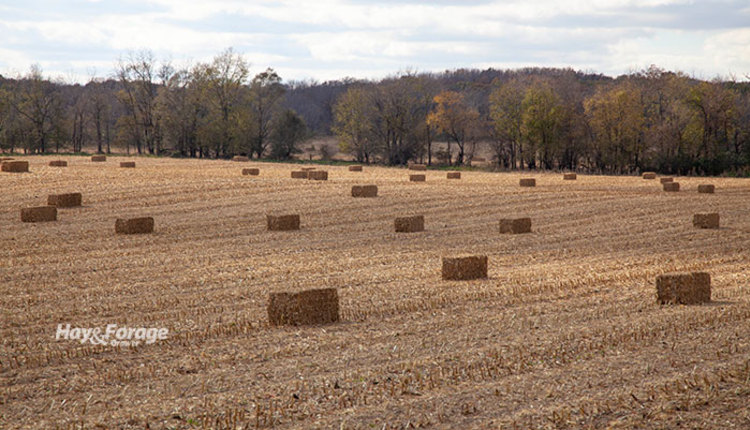
Cornstalks feed a lot of U.S. cattle during the fall and winter. Mostly, stalks are grazed, but that isn’t possible for every field or producer, and many areas this year are in short supply of forage because of drought.
Baling cornstalks can help bolster forage inventories, but attention to proper harvesting, storing, and feeding practices is needed.
Iowa State University’s Beth Reynolds and Erika Lundy-Woolfolk note that cornstalks need to be baled within four weeks of harvest to realize their full feeding potential. “Due to a high ratio of stalks to husk and leaves, the feed value of baled cornstalks is lower than if grazed,” the beef specialists write in a recent Iowa Beef Center newsletter. “Although mowing and raking tend to make baling easier, this increases the amount of dirt and ash content, which leads to feed palatability and animal health issues.”
Rather than raking, Reynolds and Lundy-Woolfolk recommend disengaging the spreader on the back of the combine to make a windrow that is predominantly leaf and husks, resulting in a higher quality bale. Ensure bales are 15% moisture or less to avoid unhealthy mold development.
Once baled, proper storage is needed to avoid losing feed value on what is already a low-quality feedstuff. “Storing bales inside or covered outside will minimize weathering effects and dry matter losses,” the specialists note. “Iowa State research found a 3% dry matter loss when cornstalk bales were stored under a roof compared to 9% when stored outside and uncovered. Deterioration rapidly increases following 120 days of storage outside as temperatures rise in early spring.”
To avoid the frustration of net wrap freezing to the ground and bales breaking, Reynolds and Lundy-Woolfolk recommend building a base to set cornstalk bales on. This might be a row of pallets, tires, lime, or even unrolling cornstalks to help keep bales up off the ground.
Prior to feeding cornstalk bales, submit a representative forage sample to your forage lab of choice. Test for the basic nutrients (protein, total digestible nutrients, and fiber) and also consider testing for mycotoxins and ash content to identify any potential negative feeding issues.
“For best results, stalks need to be ground and not offered free-choice,” the beef experts recommend. “Also, include additional moisture in the ration to improve mixability and reduce sorting.”
Fiber digestibility is often a limiting factor when feeding cornstalks. A thumb rule is that a cow can eat about 0.9% of her empty body weight in neutral detergent fiber. Therefore, the specialists suggest limiting cornstalk inclusion in the ration to about 15 pounds or less for a 1,400-pound cow.
“Contamination of bales from dirt is nearly impossible to avoid,” Reynolds and Lundy-Woolfolk assert. “Since iron is a major antagonist for other vital minerals, especially during gestation, ensure cows have continuous access to a mineral mix while feeding cornstalks.”
The beef experts further explain that organic or chelated minerals, although more expensive, have greater bioavailability and are the best option when feeding highly antagonistic feedstuffs like cornstalks and distillers grains.

